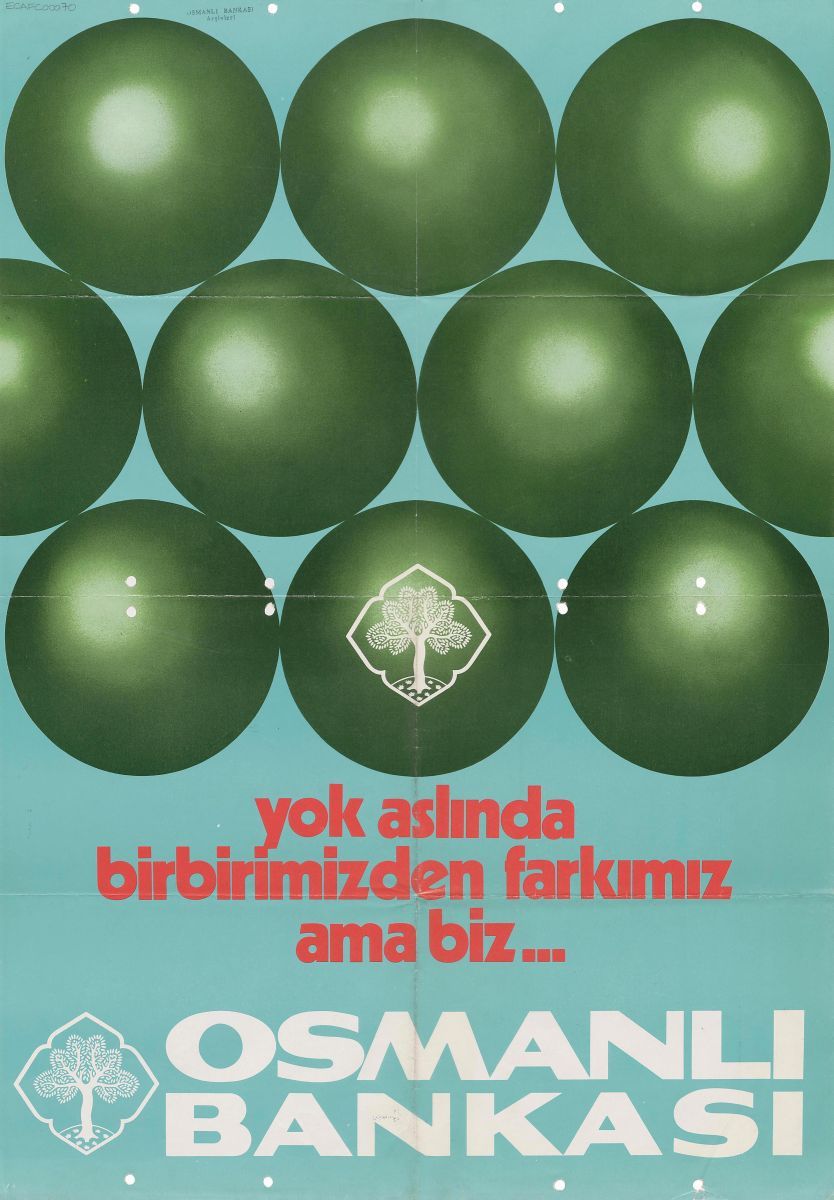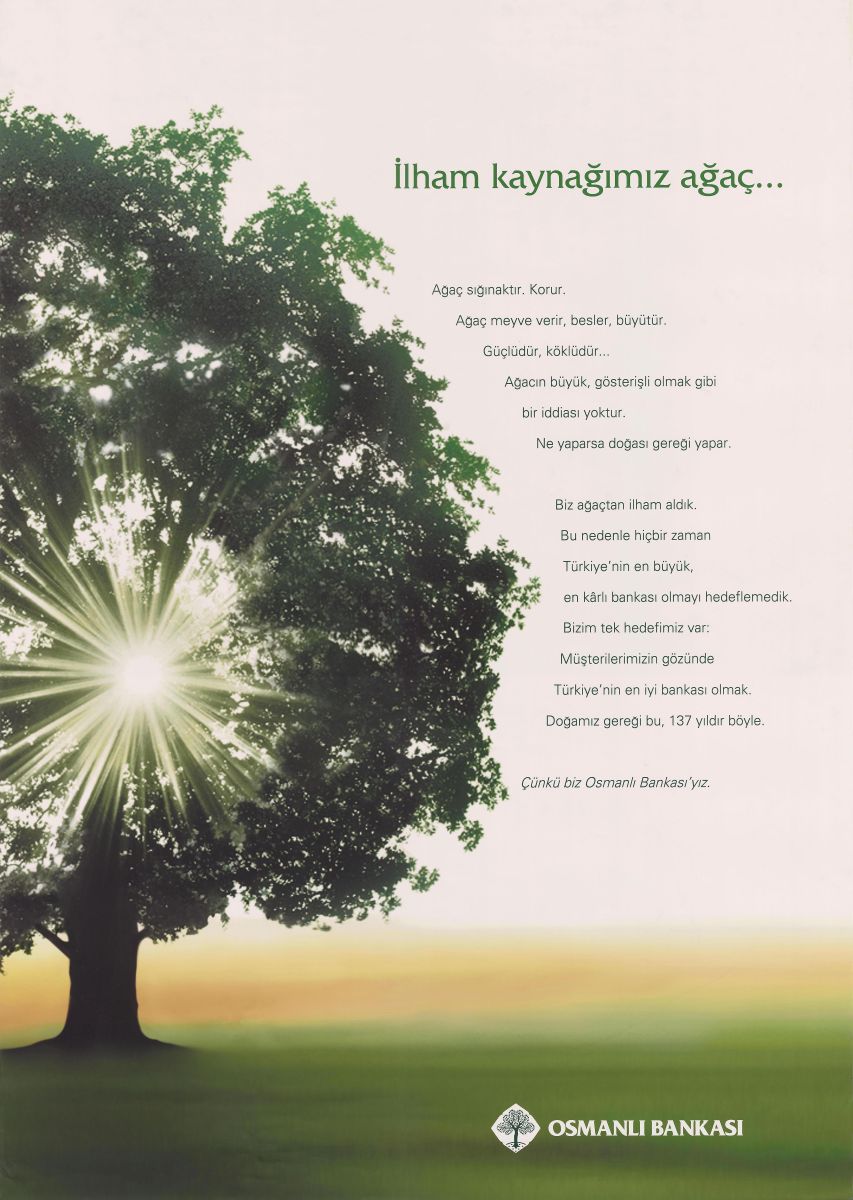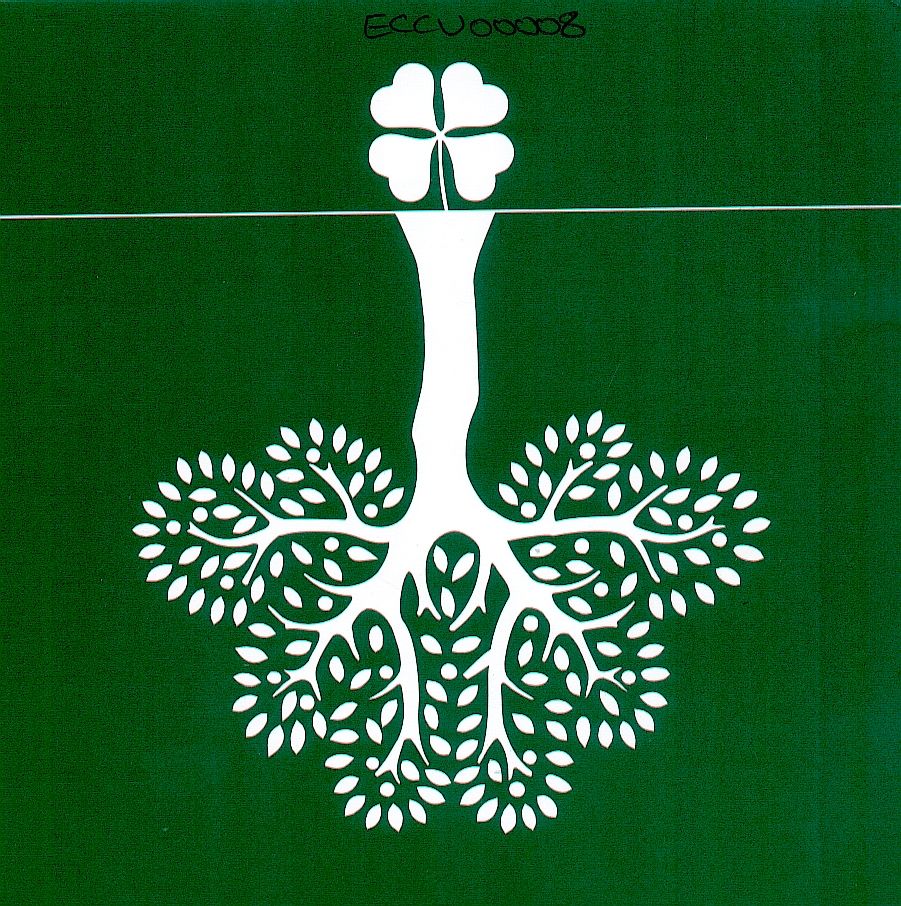Our inspiration is the tree*
Lorans Tanatar Baruh
August 11, 2023

The emblem of the Ottoman Bank, 1958
Salt Research, Ottoman Bank Archive
Salt Research, Ottoman Bank Archive
The following text is published as part of the Ottoman Bank Museum presented at Salt Galata. More stories detailing the bank’s 145-year history can be viewed at the Ottoman Bank Museum and its website.
In 1947, the Ottoman Bank, having decided to adopt some distinctive signs, consulted Edmund Dulac (1882-1953), the orientalist designer of diverse banknotes and stamps. His emblem proposal was adopted after various discussions. According to a note written in 19581, the olive tree was chosen for a number of reasons: one for being the symbol of productivity, peace, tenacity, and adaptability, and secondly, for being a native plant to all countries within the bank’s “territory.” In the illustration, the three roots refer to the bank’s institutional bases: Istanbul, London, and Paris. The branches of the tree represent the bank’s expansion abroad, and the “window,” an equilateral quadrangle found in endless variations in carpets, miniatures, screens, embroideries, interior and exterior architectural details in Islamic art, indicates Middle Eastern geography.
Thereafter, the olive tree emblem was used as the sign of the bank at its premises in London and Paris, also at its branches in the Middle East, Africa, and Turkey. In 1969, once the divisions in the Middle East and Africa were transferred to Grindlays Bank, the former name and emblem of the institution disappeared from this geography, leaving very few traces behind. In Turkey, however, the Ottoman Bank kept its branches. Even after its acquisition by Doğuş Group in 1996, it continued its activities under the name of Ottoman Bank until its merger with Garanti Bank in 2001.

The new management of 1996 decided to invest in the history of the bank, and the Ottoman Bank Archives and Research Centre was established the following year to conduct several projects on the economic and social history of Turkey. Furthermore, various publicity campaigns of the Ottoman Bank included images such as the drawings of historical branch buildings in Turkey for the 1998 calendar and the new year greeting card2. Also, with reference to its emblem, posters focusing on the symbolism of the tree were published.
The poster issued in 20003 illustrates the tree as a source of inspiration to the bank. This time, the reference taken was not the Mediterranean olive tree but the Oriental plane tree, widely planted in Turkey and well known for its longevity and durability. This monumental tree, as a symbol of greatness, permanence, superiority, and sovereignty, was also attributed to the origin of the Ottoman Empire.

The wording on the poster translated below underlines, as in the case of the olive tree, that the tree is a shelter and a symbol of productivity, protection, and tenacity; it is added that a tree is not showy or pretentious, and its innate solemnity is by nature. The conclusive sentence tells us that the aim was not to be the largest bank in Turkey but the best bank in the eyes of the customers, as it has been for 137 years, which reminds us of an earlier well-known slogan of the bank in the early 1980s: “There is no difference between the banks, but we are the Ottoman Bank”4 stressing its historical past, services, and reliability.
Our inspiration is the tree.
The tree is a shelter; it protects.
The tree bears fruit, nourishes, grows.
It’s strong; it’s rooted.
The tree has no pretensions to be big and showy.
Whatever it does, it does by nature.
We are inspired by the tree.
Therefore, we have never aimed to be
Turkey’s largest and most profitable bank.
We have only one goal:
To be the best bank in Turkey
In the eyes of our customers.
It’s in our nature; it’s been so for 137 years.
Because we are the Ottoman Bank.

One year later, the merger of the Ottoman Bank with Garanti Bank, the largest bank owned by Doğuş Group at that time, was symbolized in a new year’s greeting card, ironically, with an upside-down olive tree, which strengthened the clover of Garanti Bank.
*The first version of this article was published in eabh (The European Association for Banking and Financial History) Bulletin’s 2023 issue, “Posters in Finance” (eds. Carmen Hofmann & Gabriella Massaglia).
- - -
Lorans Tanatar Baruh graduated from the Department of Economics at Boğaziçi University, and obtained her master’s and doctorate degrees in History from the same university. In 1997 and 2002, she was respectively involved in setting up the Ottoman Bank Archive and Research Centre and the Ottoman Bank Museum. Her research and publications mainly focus on the economic, social, and urban history of the 19th and 20th centuries Istanbul, and on private archives. She is currently the Associate Director of Salt Research and Programs.
In 1947, the Ottoman Bank, having decided to adopt some distinctive signs, consulted Edmund Dulac (1882-1953), the orientalist designer of diverse banknotes and stamps. His emblem proposal was adopted after various discussions. According to a note written in 19581, the olive tree was chosen for a number of reasons: one for being the symbol of productivity, peace, tenacity, and adaptability, and secondly, for being a native plant to all countries within the bank’s “territory.” In the illustration, the three roots refer to the bank’s institutional bases: Istanbul, London, and Paris. The branches of the tree represent the bank’s expansion abroad, and the “window,” an equilateral quadrangle found in endless variations in carpets, miniatures, screens, embroideries, interior and exterior architectural details in Islamic art, indicates Middle Eastern geography.
Thereafter, the olive tree emblem was used as the sign of the bank at its premises in London and Paris, also at its branches in the Middle East, Africa, and Turkey. In 1969, once the divisions in the Middle East and Africa were transferred to Grindlays Bank, the former name and emblem of the institution disappeared from this geography, leaving very few traces behind. In Turkey, however, the Ottoman Bank kept its branches. Even after its acquisition by Doğuş Group in 1996, it continued its activities under the name of Ottoman Bank until its merger with Garanti Bank in 2001.

Ottoman Bank poster: “There is no difference between the banks, but we are…”
Salt Research, Ottoman Bank Archive
Salt Research, Ottoman Bank Archive
The new management of 1996 decided to invest in the history of the bank, and the Ottoman Bank Archives and Research Centre was established the following year to conduct several projects on the economic and social history of Turkey. Furthermore, various publicity campaigns of the Ottoman Bank included images such as the drawings of historical branch buildings in Turkey for the 1998 calendar and the new year greeting card2. Also, with reference to its emblem, posters focusing on the symbolism of the tree were published.
The poster issued in 20003 illustrates the tree as a source of inspiration to the bank. This time, the reference taken was not the Mediterranean olive tree but the Oriental plane tree, widely planted in Turkey and well known for its longevity and durability. This monumental tree, as a symbol of greatness, permanence, superiority, and sovereignty, was also attributed to the origin of the Ottoman Empire.

Ottoman Bank poster: “Our Inspiration is the tree,” 2000
Salt Research, Ottoman Bank Archive
Salt Research, Ottoman Bank Archive
The wording on the poster translated below underlines, as in the case of the olive tree, that the tree is a shelter and a symbol of productivity, protection, and tenacity; it is added that a tree is not showy or pretentious, and its innate solemnity is by nature. The conclusive sentence tells us that the aim was not to be the largest bank in Turkey but the best bank in the eyes of the customers, as it has been for 137 years, which reminds us of an earlier well-known slogan of the bank in the early 1980s: “There is no difference between the banks, but we are the Ottoman Bank”4 stressing its historical past, services, and reliability.
Our inspiration is the tree.
The tree is a shelter; it protects.
The tree bears fruit, nourishes, grows.
It’s strong; it’s rooted.
The tree has no pretensions to be big and showy.
Whatever it does, it does by nature.
We are inspired by the tree.
Therefore, we have never aimed to be
Turkey’s largest and most profitable bank.
We have only one goal:
To be the best bank in Turkey
In the eyes of our customers.
It’s in our nature; it’s been so for 137 years.
Because we are the Ottoman Bank.

Garanti Bank greeting card
Salt Research, Ottoman Bank Archive
Salt Research, Ottoman Bank Archive
One year later, the merger of the Ottoman Bank with Garanti Bank, the largest bank owned by Doğuş Group at that time, was symbolized in a new year’s greeting card, ironically, with an upside-down olive tree, which strengthened the clover of Garanti Bank.
*The first version of this article was published in eabh (The European Association for Banking and Financial History) Bulletin’s 2023 issue, “Posters in Finance” (eds. Carmen Hofmann & Gabriella Massaglia).
Lorans Tanatar Baruh graduated from the Department of Economics at Boğaziçi University, and obtained her master’s and doctorate degrees in History from the same university. In 1997 and 2002, she was respectively involved in setting up the Ottoman Bank Archive and Research Centre and the Ottoman Bank Museum. Her research and publications mainly focus on the economic, social, and urban history of the 19th and 20th centuries Istanbul, and on private archives. She is currently the Associate Director of Salt Research and Programs.
- 1.Salt Research, Ottoman Bank Archive, London, LA24040, "Notes concerning the emblem of the Ottoman Bank", February 2, 1958. https://archives.saltresearch.org/handle/123456789/13852
- 2.Salt Research, Ottoman Bank Archive, ECCV00021, "Osmanlı Bankası kutlama kartı. 1998'in sizin yaşamınıza da güzel değişiklikler getirmesi dileğiyle", 1998. https://archives.saltresearch.org/handle/123456789/151624
- 3.Salt Research, Ottoman Bank Archive, ECAFC00085, "Osmanlı Bankası afiş. İlham kaynağımız ağaç", 2000. https://archives.saltresearch.org/handle/123456789/131819
- 4.Salt Research, Ottoman Bank Archive, ECAFC00070, "Osmanlı Bankası afiş. Yok aslında birbirimizden farkımız ama biz..." https://archives.saltresearch.org/handle/123456789/164811, and ECAFC00033, "Osmanlı Bankası afiş. Yok aslında birbirimizden farkımız ama biz Osmanlı Bankası'yız." https://archives.saltresearch.org/handle/123456789/164500

